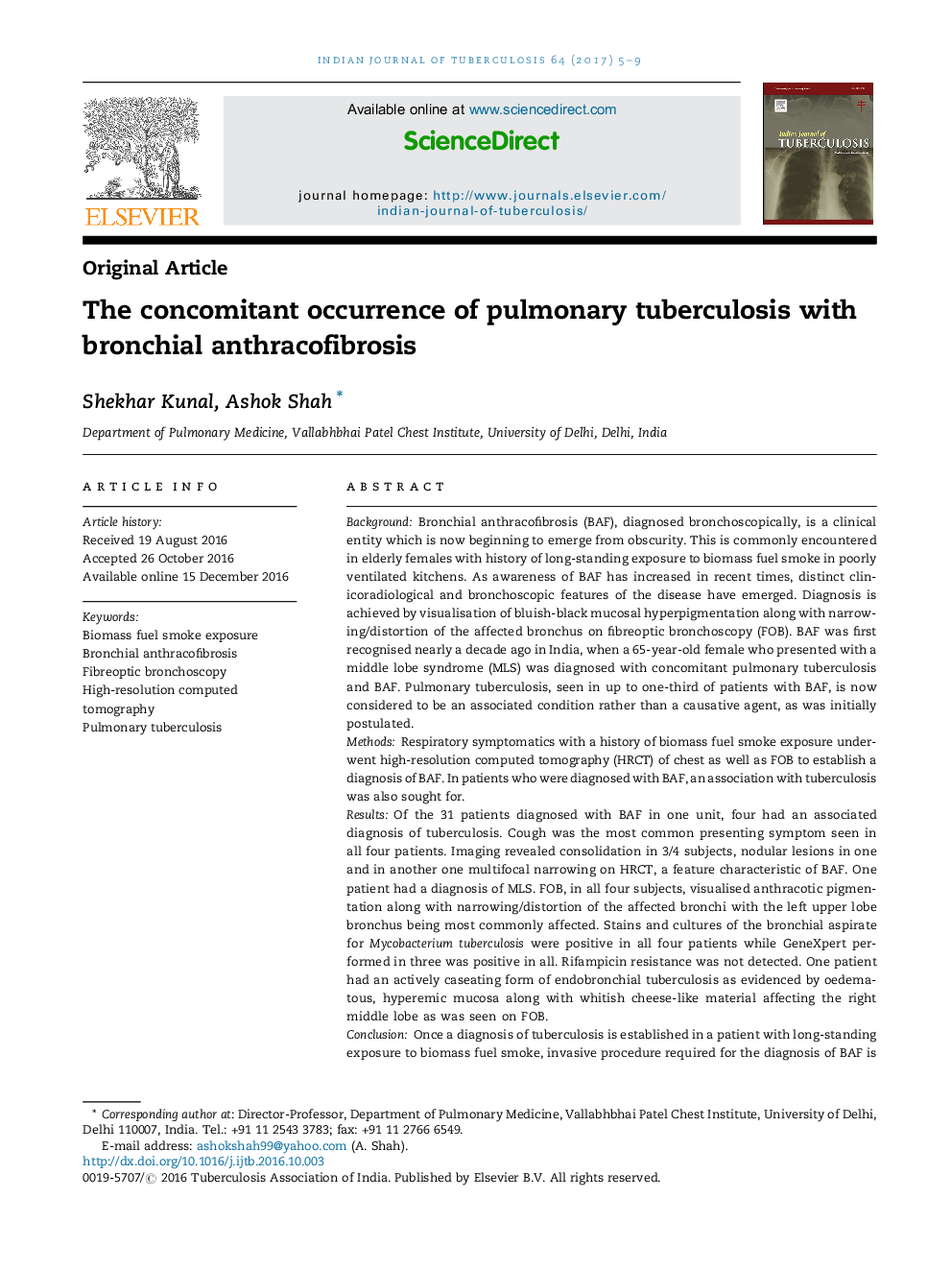| کد مقاله | کد نشریه | سال انتشار | مقاله انگلیسی | نسخه تمام متن |
|---|---|---|---|---|
| 5672373 | 1593197 | 2017 | 5 صفحه PDF | دانلود رایگان |
- This is an original article, which focuses on concomitant occurrence of bronchial anthracofibrosis with tuberculosis in India.
- Bronchial anthracofibrosis is caused due to long standing exposure to biomass fuel smoke in poorly ventilated kitchens.
- Bronchial anthracofibrosis is a bronchoscopic diagnosis characterised by presence of anthracotic pigmentation associated with narrowing/distortion of the affected bronchus.
- This clinical entity is frequently associated with pulmonary tuberculosis, chronic obstructive pulmonary disease, pneumonia and lung malignancy.
BackgroundBronchial anthracofibrosis (BAF), diagnosed bronchoscopically, is a clinical entity which is now beginning to emerge from obscurity. This is commonly encountered in elderly females with history of long-standing exposure to biomass fuel smoke in poorly ventilated kitchens. As awareness of BAF has increased in recent times, distinct clinicoradiological and bronchoscopic features of the disease have emerged. Diagnosis is achieved by visualisation of bluish-black mucosal hyperpigmentation along with narrowing/distortion of the affected bronchus on fibreoptic bronchoscopy (FOB). BAF was first recognised nearly a decade ago in India, when a 65-year-old female who presented with a middle lobe syndrome (MLS) was diagnosed with concomitant pulmonary tuberculosis and BAF. Pulmonary tuberculosis, seen in up to one-third of patients with BAF, is now considered to be an associated condition rather than a causative agent, as was initially postulated.MethodsRespiratory symptomatics with a history of biomass fuel smoke exposure underwent high-resolution computed tomography (HRCT) of chest as well as FOB to establish a diagnosis of BAF. In patients who were diagnosed with BAF, an association with tuberculosis was also sought for.ResultsOf the 31 patients diagnosed with BAF in one unit, four had an associated diagnosis of tuberculosis. Cough was the most common presenting symptom seen in all four patients. Imaging revealed consolidation in 3/4 subjects, nodular lesions in one and in another one multifocal narrowing on HRCT, a feature characteristic of BAF. One patient had a diagnosis of MLS. FOB, in all four subjects, visualised anthracotic pigmentation along with narrowing/distortion of the affected bronchi with the left upper lobe bronchus being most commonly affected. Stains and cultures of the bronchial aspirate for Mycobacterium tuberculosis were positive in all four patients while GeneXpert performed in three was positive in all. Rifampicin resistance was not detected. One patient had an actively caseating form of endobronchial tuberculosis as evidenced by oedematous, hyperemic mucosa along with whitish cheese-like material affecting the right middle lobe as was seen on FOB.ConclusionOnce a diagnosis of tuberculosis is established in a patient with long-standing exposure to biomass fuel smoke, invasive procedure required for the diagnosis of BAF is usually not considered and the diagnosis would remain confined to pulmonary tuberculosis. This study highlights the need to recognise BAF and to exclude pulmonary tuberculosis in such patients.
Journal: Indian Journal of Tuberculosis - Volume 64, Issue 1, January 2017, Pages 5-9
